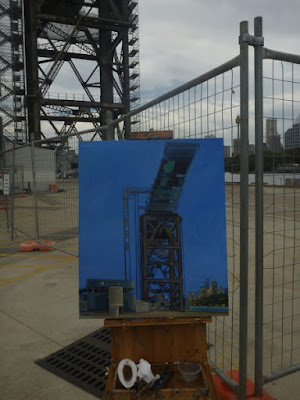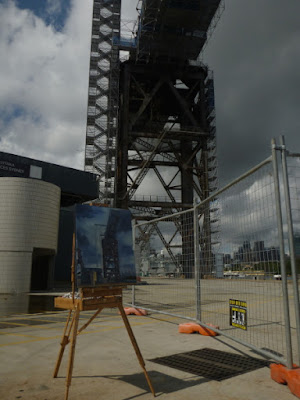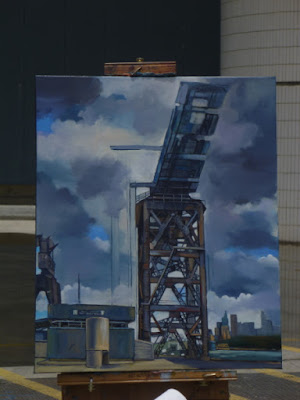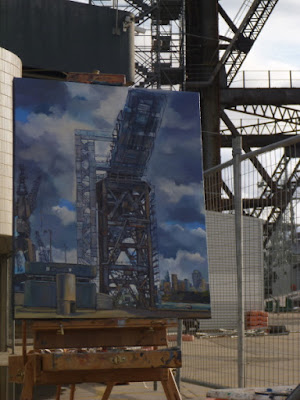 |
Starting to paint my canvas of the
"Hammerhead Crane from Garden Island"
2014 oil on canvas 91 x 61cm Enquiries |
The Hammerhead Crane was constructed between 1944 – 1951 as part of a major development of the Garden Island naval facilities that also included the Captain Cook graving dock.
It was originally intended to serve the ships of both the British and Australian Navies.
The British Navy had access to the 250 ton Hammerhead Crane at Singapore until 1942. When Singapore fell, this crane was destroyed, but its design and steelwork construction drawings were reused for the Garden Island crane.
 |
Starting to paint my canvas of the
"Hammerhead Crane from Garden Island"
2014 oil on canvas 91 x 61cm
Enquiries
|
The crane designer was Sir William Arrol Co Ltd of Glasgow, with Sir Alexander Gibb and Partners of London as consultants.
The 250 ton crane was the largest size of the 18 Arrol Titans constructed from 1910 to 1960. The Garden Island Hammerhead Crane was one of the six 250 ton Arrol Titans.
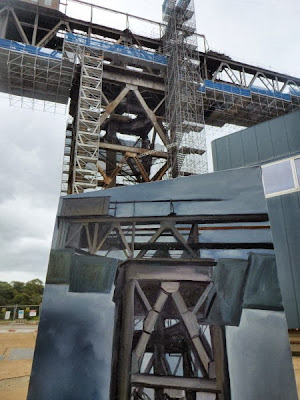 |
Painting my canvas of the
"Hammerhead Crane from Garden Island"
2014 oil on canvas 91 x 61cm
Enquiries
|
Between 1989 – 1991 the crane capacity was reduced and inspections and repairs were carried out.
In 1995 Jigger hoist was withdrawn from service due to runway corrosion.
1996 seems to have been the last known date of operation.
 |
Painting my canvas of the
"Hammerhead Crane from Garden Island"
2014 oil on canvas 91 x 61cm Enquiries
|
Large riveted structures have an inherent problem.
They have, by the nature of their construction, many inaccessible surfaces which can't be completely sealed against water and are therefore prone to corrosion.
.jpg) |
Work in progress on the easel
|
"Hammerhead Crane from Garden Island"
2014 oil on canvas 91 x 61cm
This problem was well understood by the designers of the Hammerhead.
Their specifications required that all surfaces to be brought together should be painted with two coats of red lead in boiled linseed oil as a corrosion protective coating, before fit up and riveting. The surfaces were supposed to be brought together while the 2nd paint layer was still wet.
This was the normal procedure to limit corrosion on inaccessible surfaces.
.jpg) |
Painting my canvas of the
"Hammerhead Crane from Garden Island"
2014 oil on canvas 91 x 61cm
|
However, according to the Hammerhead Crane report by Godden Mackay Logan an analysis of the paint layers is as follows:
Substrate: Dark Brown Mill Scale on Steel
First paint layer: Yellow Zinc Chromate Primer
Second Paint Layer: Light Grey Aluminium Top-Coat
Third Paint Layer: Dark Orange Red Lead Primer
Fourth Paint Layer: Grey Alkyd MIO
 |
Painting my canvas of the
"Hammerhead Crane from Garden Island"
2014 oil on canvas 91 x 61cm
|
A Zinc Chromate primer as well as a second coat of grey aluminium paint lie underneath the layer of red lead over most of the crane.
This was completely contrary to the original specifications of the designers. And with good reason.
Red lead is intended for direct application to ferrous substrates, so it is of limited value when applied over existing paint.
So there.
 |
Painting my canvas of the
"Hammerhead Crane from Garden Island"
2014 oil on canvas 91 x 61cm Enquiries |
Red lead/Lead tetraoxide (Formula: Pb3O4) is a bright red, heavy, water and alcohol insoluble, poisonous compound and has been used as a pigment since the time of the Roman empire. It was originally known as minium, after the Minius River in northwest Spain where it was first mined. Red lead was usually obtained as a powder by heating the yellow lead ore known as litharge. In the medieval period it was used as a pigment in the production of illuminated manuscripts, and gave its name to the miniature.
In combination with linseed oil, red lead is incomparably useful as a thick, long-lasting anti-corrosive paint.
However red lead is also notoriously and horribly toxic.
But then, so is zinc chromate.
 |
Painting my canvas of the
"Hammerhead Crane from Garden Island"
2014 oil on canvas 91 x 61cm
|
Every now and then I can see a sallow greenish yellow hue seeping mockingly through the apparently uniform grey top coat.
What were they thinking when they applied the zinc chromate primer?
The combination of a zinc based primer and aluminium based 2nd coat makes me suspect that the first painters of the Hammerhead were attempting a "zinc-alume" solution. The theory is that aluminium and zinc oxides will migrate to a scratched surface and provide enhanced corrosion protection.
In practice, it didn't work.
 |
GIHC6 ' Looking up at the Hammerhead Crane'
2014 oil on paper 12 x 12cm
Enquiries |
There are large areas of breakdown and surface corrosion occurring on the Hammerhead Crane where the paint layers have failed.
Rusting through the paint due to corroding millscale is also common.
Rust is a common metaphor, even a cliche, for slow decay. It gradually but thoroughly corrupts robust iron and steel metal into a soft crumbling powder.
In my paintings, I am grateful for the patches of rust. They add a dash of much needed warmth and texture to contrast with the monotony of the cool grey colour of the steel.
But in real life, rust is something I am sorry to see. It speaks of neglect, of compromise, of lack of foresight, of laziness, of apathy, of failure to preserve and protect.
Decay is not merely physical.









.jpg)
.jpg)












